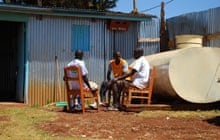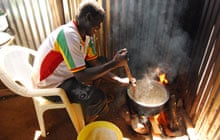I’m sitting on a plastic chair in a small garden. The new, eight-foot high corrugated iron fence that seals us off from the patchwork of houses outside is reflecting the sun in my eyes. I turn my chair slightly so I’m facing away from it, and put my feet up on a small stool.
“More tea?” Kiptum, the camp cook asks, bringing over a flask. Edwin Kipyego, a talented young half marathon runner who last year won a string of races in the UK, takes the flask and fills my cup to the top, and then refills his own cup. Then we sit back and continue doing what we’ve been doing for most of the day: nothing.
For Kenyan runners, rest is a serious business. I spoke to some top British athletes who had come to Kenya to train, and I asked them what they thought the biggest difference was between the Kenyans’ training and their own.
“Rest,” they said, unanimously.
So, here I am, resting. I’m spending the day at one of Iten’s newest training camps, called, simply, Run Fast. There are 10 athletes living here, in five small dormitories, each with a shower, a sofa and a bunk bed. Nine of the athletes are Kenyan and one is British. Last year Tom Payn, one of the UK’s fastest marathon runners, was working as a technical sales engineer for a filtration company in Portsmouth, before he decided to quit his job and move to Kenya to become a full-time athlete.
“I wasn’t enjoying my running,” he tells me, sitting under the camp’s newly built thatched shade. “But since I’ve been here, I’m loving it.” He grins like he can’t quite believe his luck. “I’m always looking forward to the next run.”
After my humbling at a recent cross country race in nearby Eldoret, I’ve joined Tom at the camp in an effort to give my own training a boost.

The day starts at 6.20am outside a tiny hotel on the main road in Iten. It’s really just a wooden shack, no bigger than a garden shed. “Is it really a hotel?” I ask one of the other runners waiting outside. He shrugs his shoulders.
A big group of runners has congregated. As well as the 10 athletes in the camp, Run Fast has a group of second-string runners who live outside the camp but come to the training sessions.
The aim of every runner is to get into a camp. Once inside, they get given a free bed and three meals a day. Being in the camp also means they’re just one step away from being sent off to race abroad. And that’s when things can really start to happen.
Once they get entered into races in abroad, all they have to do is run like Kenyans and watch the money start rolling in. Last year Edwin won enough prize money to buy himself a plot of land when he got back. He’s looking forward to returning to Europe in the next few weeks to plunder some more winnings.
As usual, it’s a bright, crisp morning in Iten. By the time we get to the track, it’s still only 7am, but already there are groups of runners hurtling around mid-session.
The Run Fast schedule is for 12 x 600m and 12 x 400m. I decide to do a cutdown version of the session, with fewer runs and bigger rests, in the hope that I’ll be able to keep up.
It’s evident from the first 600m, however, that that won’t be the case. I find myself almost sprinting around the dirt track, stumbling all over the place as I try to run in the trench that has been worn all around the inside lane. By the end, they’re all far ahead of me, getting ready to do the next one.
In the end, I manage to do a quarter of the track session before my legs give out. With each interval they feel heavier, and I get further and further behind. I’m finding it hard to breathe. I’ve been here about six weeks now but I’m still struggling with the altitude.

Back at the camp after the session we are given a mango and a banana each. Then we sit down and drink our sweet, milky tea and eat dry bread. The food is doled out by Kiptum as people find themselves a chair to kick back in. The remainder of the day, until the afternoon run at 5pm, is dedicated to resting.
Some time in the mid-afternoon I realise I’m the only person still sitting out in the garden. I get up to see where everyone has wandered off to. Some have gone to sleep, but in Tom’s room I find four of the runners watching a music video. As the sole mzungu [European] in the camp, Tom gets special privileges. Simple things, like a TV, a hi-fi, and a hot shower.
But having a TV isn’t always a blessing. Most days it means his room gets taken over by the other runners. Like now. The video they’re watching consists solely of curvaceous ladies in a variety of surreal settings grinding away to up-tempo Kalenjin music. In one scene the lady is standing next to a computer in a home office, while in another she’s standing in a school playing field on what looks like sports day.
After a day of such frivolities, the camp’s athletes don’t seem too keen to do their evening run. A few of them decide they need to rest, while the rest of us head out for a 40-minute run.
It’s a lovely time of day, with the air just cooling and the light turning yellow. It’s the first time I’ve ever trained twice in one day, but I feel surprisingly good. For them, of course, it’s only an easy recovery run, but in my head we’re racing along, the wind in our hair. Finally, here I am, keeping up, running with the Kenyans.
• The book Running with the Kenyans by Adharanand Finn will be published in 2012
Source: Read Full Article
